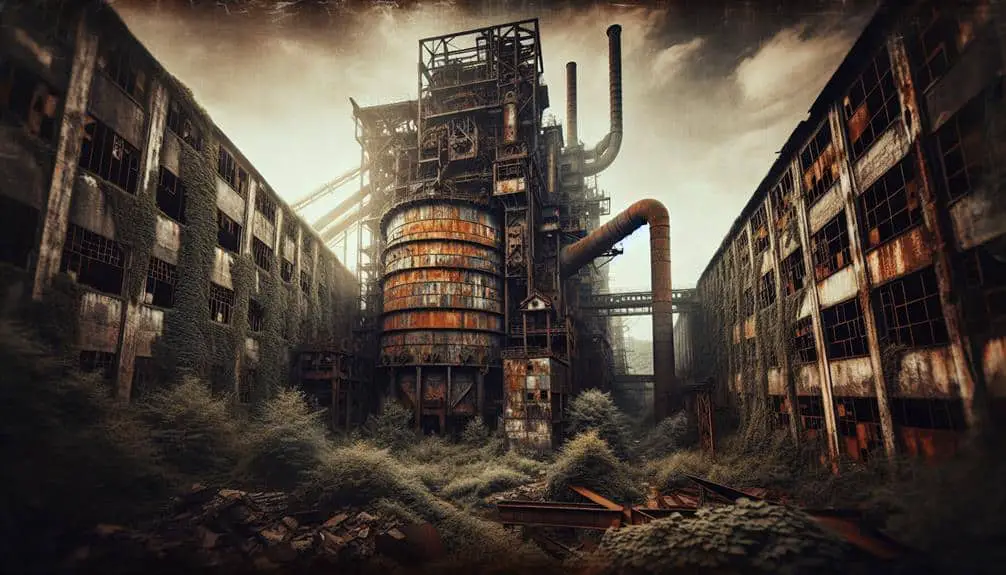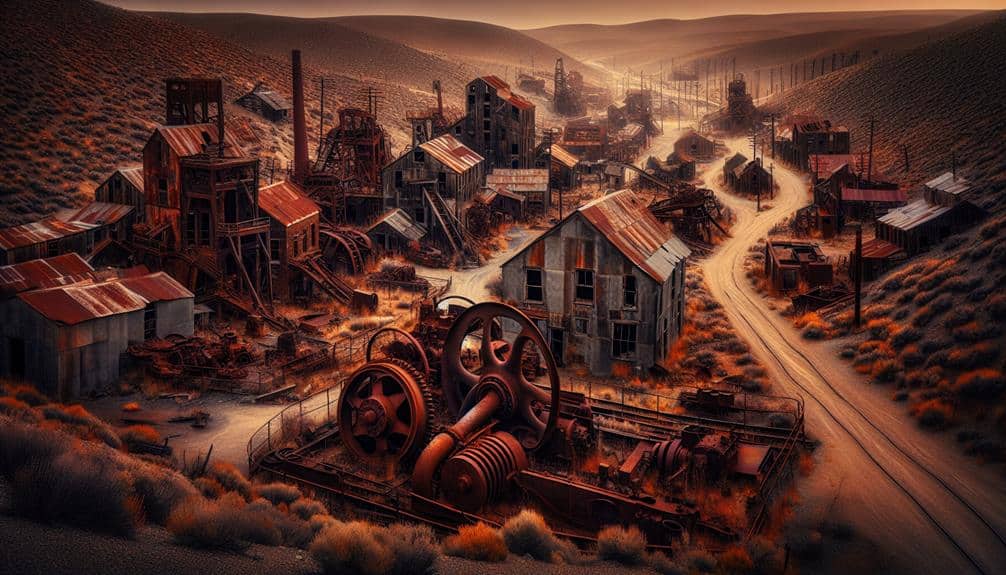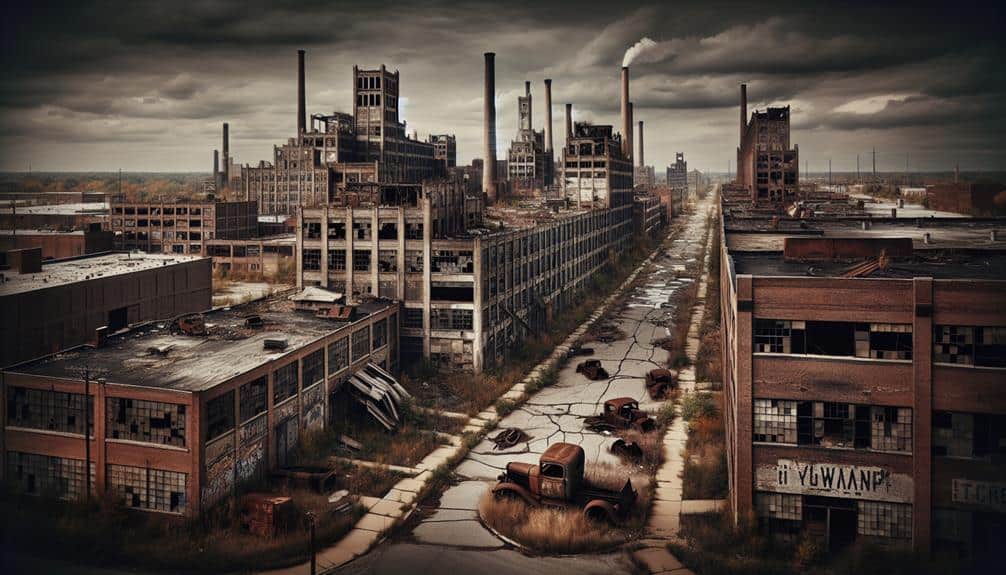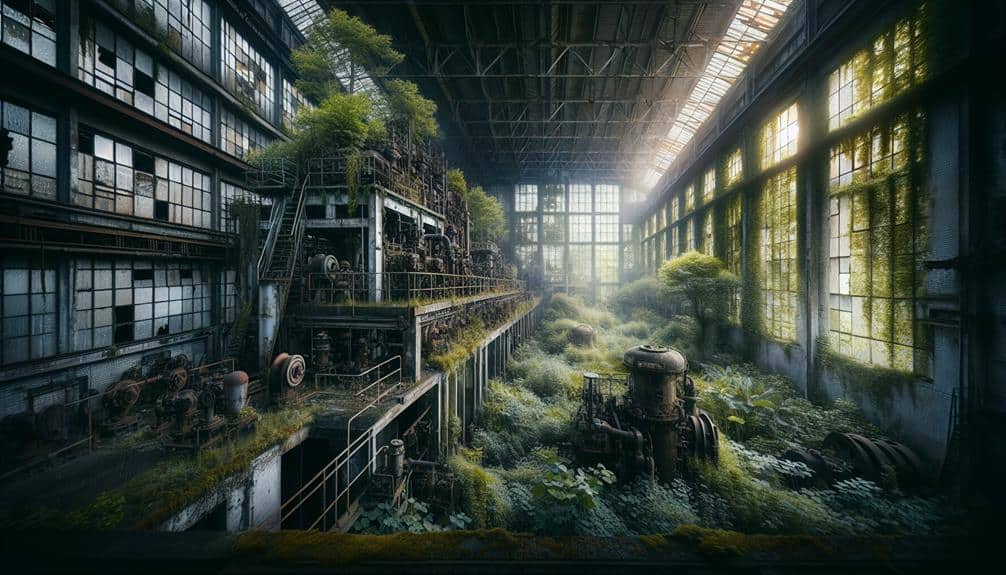In abandoned smelting towns, you'll find remnants like decaying factories, silent witnesses to a once-thriving industrial era. These structures echo a tale of prosperity turned to neglect, offering a glimpse into the rise and fall of industries. The haunting atmosphere preserves the stories of perseverance and transformation within the walls of old machinery. Explore these relics to uncover a rich history that intertwines culture, economics, and innovation. Discover the secrets each building holds about the people who shaped these towns. More details await about the architectural, environmental, tourism, and preservation aspects of these forgotten places.
Key Points
- Decaying factories and furnaces stand as reminders of industrial glory turned to ruins.
- Echoes of past machinery and structures reveal the once-thriving industrial landscape.
- Haunting architectural remnants narrate tales of prosperity followed by abandonment.
- Soil, water, and air pollution remnants pose environmental challenges in these abandoned areas.
- Tourism potential offers unique insights into the industrial past, attracting explorers and history enthusiasts.
Historical Significance of Abandoned Smelting Towns
The historical significance of abandoned smelting towns lies in their tangible connection to the industrial revolution and the economic transformations of the past centuries. These towns, once vibrant hubs of industry, now stand as remnants of a bygone era, echoing the cultural heritage and economic decline that shaped them. As you explore these ghost towns, you're confronted with a visual representation of the rise and fall of industries that once thrived, leaving behind a legacy of both prosperity and hardship.
The cultural heritage embedded within these abandoned smelting towns offers a glimpse into the lives of the people who lived and worked there. The remnants of old factories, rusted machinery, and dilapidated homes serve as a stark reminder of the economic decline that led to the eventual abandonment of these once-booming settlements. Walking through these deserted streets, you can almost hear the echoes of the past, telling stories of perseverance, struggle, and ultimately, transformation.
Architectural Remnants in Ghost Towns
Amidst the desolate landscapes of abandoned smelting towns, the architectural remnants stand as silent witnesses to a once-thriving industrial past. These industrial ruins, once bustling with activity, now offer a peek into the lives of the workers who inhabited these towns. The decaying factories, warehouses, and company buildings tell a story of prosperity turned to abandonment.
Urban exploration in these ghost towns reveals a mix of nostalgia and eeriness. As you traverse the crumbling structures, you can almost hear the echoes of the machinery that once roared within these walls. The layers of dust and rust create a haunting atmosphere, drawing you into a world frozen in time.
Each building holds its own secrets, from the towering smokestacks to the intricate details of the architecture. The peeling paint and broken windows add to the sense of decay, yet there's a strange beauty in the way nature intertwines with human-made structures. Exploring these architectural remnants is like stepping into a forgotten chapter of history, where the past whispers its tales of industry and innovation.
Environmental Impact of Mining Leftovers
With mining leftovers from deserted smelting towns, the environmental impact is a complex network of ecological repercussions intertwined with historical industrial activities. The pollution effects stemming from these remnants can persist for decades, affecting both the land and water systems. Ecosystem restoration efforts face significant challenges due to the extensive damage caused by mining activities.
Here are some key points to keep in mind:
- Soil Contamination: Heavy metals and toxins leached from mining waste can contaminate the soil, making it unsuitable for vegetation growth.
- Water Pollution: Runoff from abandoned mining sites can carry pollutants into nearby water bodies, disrupting aquatic ecosystems and affecting water quality.
- Air Quality Issues: Dust and particulate matter generated by exposed mining leftovers can degrade air quality, impacting both human health and wildlife.
- Long-Term Impact: The legacy of mining activities can have enduring consequences, requiring sustained efforts to mitigate pollution effects and restore ecosystems.
Navigating the intricate balance between addressing pollution effects and promoting ecosystem restoration is vital in mitigating the environmental impact of mining leftovers from abandoned smelting towns.
Tourism Potential in Forgotten Industrial Sites
Exploring the forgotten industrial sites offers a unique opportunity to uncover the rich history and potential for tourism development in these abandoned areas. Urban exploration enthusiasts and photo tourism aficionados are increasingly drawn to these locations, seeking to capture the beauty of decay and the stories embedded in rusting machinery and crumbling buildings. These sites hold a significant industrial heritage, serving as poignant reminders of a bygone era and offering a glimpse into the past. The allure of exploring these abandoned smelting towns lies in the chance to witness firsthand the remnants of a once-thriving industry and the communities that supported it.
Moreover, these forgotten industrial sites have the potential to become unique tourism attractions, attracting history buffs, adventure seekers, and curious travelers. By promoting responsible tourism practices, such as respecting the environment and preserving the sites' integrity, these locations can be transformed into educational and memorable destinations. The combination of industrial history, urban exploration, and photo tourism creates a compelling narrative that appeals to a diverse range of visitors, highlighting the untapped tourism potential of these forgotten industrial sites.
Preservation Efforts for Smelting Town Relics
The allure of abandoned smelting towns as potential tourism attractions is intricately tied to the ongoing preservation efforts aimed at safeguarding the relics of these once-thriving industrial sites. Restoration projects play an essential role in maintaining the historical integrity of these towns, allowing visitors to immerse themselves in the rich heritage of the past. Community engagement is pivotal in ensuring that these relics aren't forgotten, fostering a sense of collective responsibility towards preserving the legacy of these smelting towns for future generations.
- Volunteers meticulously restoring dilapidated smelting furnaces, breathing new life into these industrial giants.
- Local artisans crafting intricate metalwork using traditional smelting techniques, keeping ancient skills alive.
- Educational workshops teaching visitors about the history of smelting towns, enlightening minds about the industrial revolution's impact.
- Guided tours led by passionate historians, unraveling the stories behind each rusted gear and abandoned building, painting a vivid picture of the town's vibrant past.
Frequently Asked Questions
How Did the Decline of the Smelting Industry Impact the Local Economy and Surrounding Communities?
When the smelting industry dwindled, the local economy suffered job losses and reduced revenue, affecting communities. Environmental damage and social upheaval followed, highlighting the interconnectedness of industry, economy, and society in a delicate balance.
What Are Some of the Lesser-Known Abandoned Smelting Towns That Have Been Discovered in Recent Years?
You've discovered some lesser-known abandoned smelting towns that hold both historical significance and environmental impact. Preservation efforts have highlighted industrial artifacts in these towns, shedding light on the past while fostering a sense of appreciation.
Are There Any Ghost Stories or Urban Legends Associated With Abandoned Smelting Towns?
Ghost stories and urban legends often surround abandoned smelting towns. You may hear chilling tales of ghostly encounters and haunted histories. These stories add an eerie layer to the already haunting atmosphere of these forgotten places.
What Challenges Do Archaeologists Face When Trying to Excavate and Study Abandoned Smelting Towns?
When excavating abandoned smelting towns, challenges arise for archaeologists. Techniques must adapt to the decayed structures and hazardous environments. Safety concerns, structural instability, and limited historical records complicate efforts, demanding careful planning and specialized skills.
How Do Abandoned Smelting Towns Compare to Other Types of Ghost Towns, Such as Those Left Behind by the Logging or Railroad Industries?
When comparing abandoned smelting towns to logging or railroad ghost towns, economic impact stands out. Industrial relics in smelting towns reveal massive infrastructures, impacting local economies. Environmental restoration and historical preservation efforts in these unique towns face complex challenges but offer rich historical insights.



